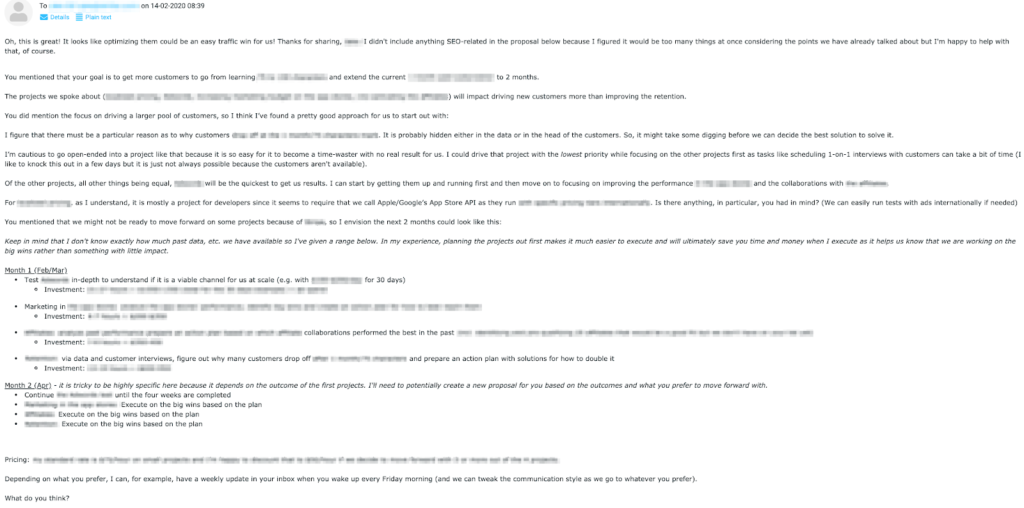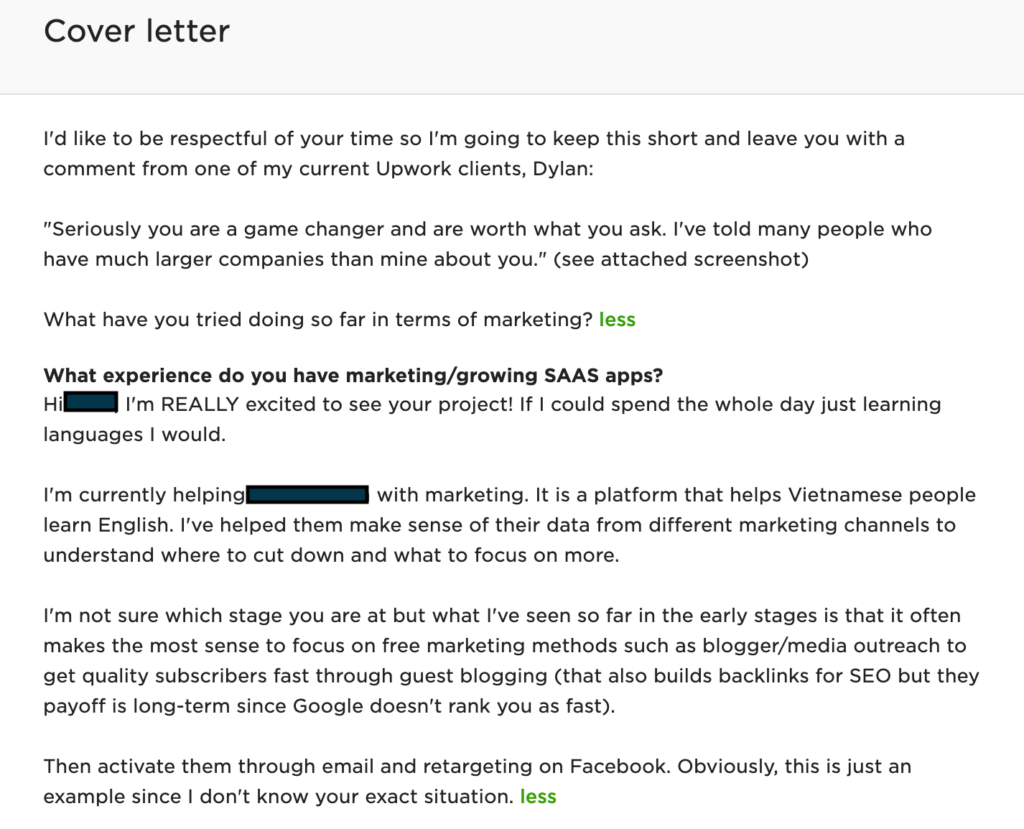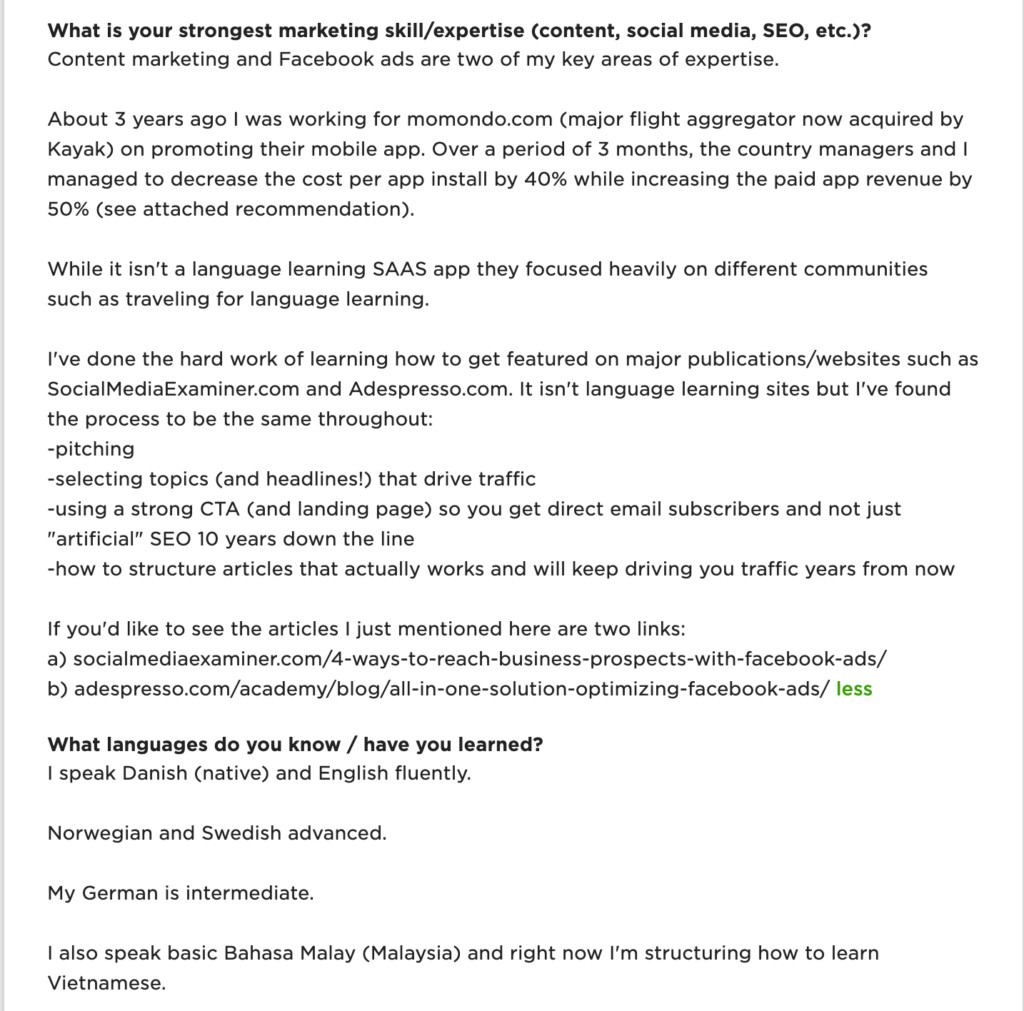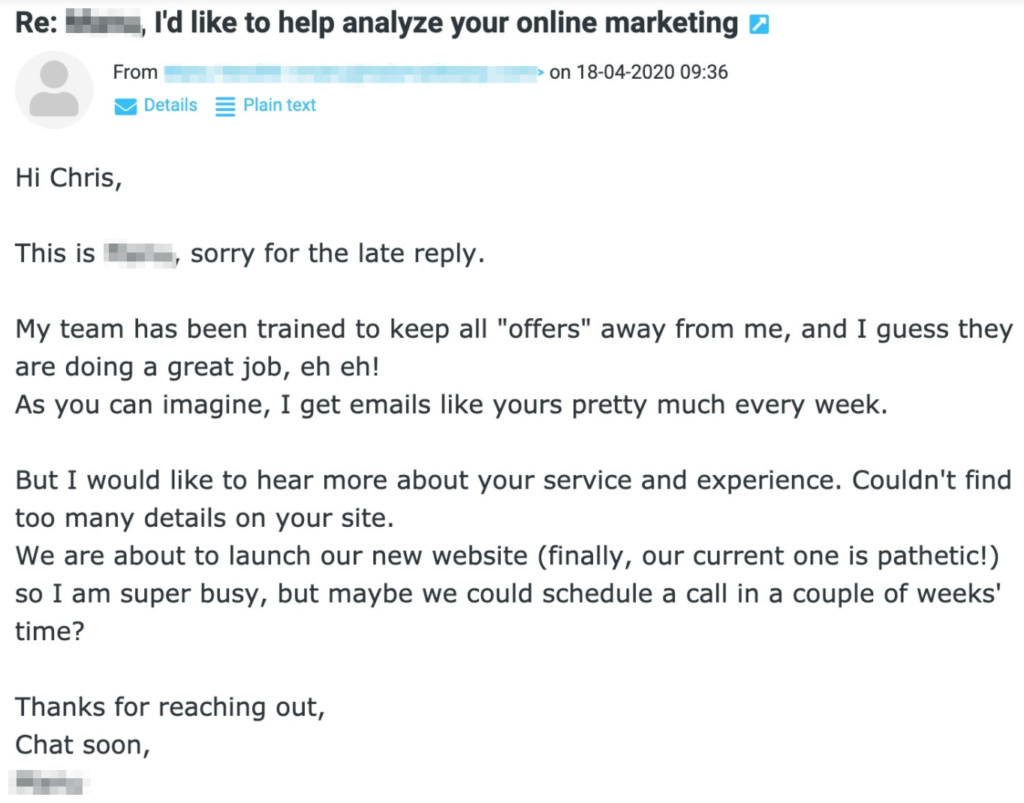Years ago, as a last-minute attempt to improve a pitch before the deadline, I was searching online for how to write a pitch. Back then, my pitches would always end with someone saying “I can tell you know a lot about the subject… we’ll get back to you” followed by painful radio silence.
This went on for YEARS until I realized that something I did wasn’t working, and I decided to figure out what it was and change it.
In this case study, I show what happened when I sent out 303 pitches.

I landed 17 clients which might not sound like a lot until we dive deeper. We’ll notice that almost all of them were sent out cold — to businesses that I had not interacted with before and that didn’t know me.
What this doesn’t show you is that I’ve since landed about 10 projects from 15 pitches to businesses that already knew me worth way more than the earnings in that case study. I’ll probably prepare a new case study showing that soon.
As I’ve practiced more and more, I’ve learned a different approach that helped me tremendously. In this article, I’ll share my thoughts with you based on my experience pitching projects to businesses as a remote freelancer.
The 4 pitch killers we often make
There are a few things that almost surely destroy our chance of writing a pitch that wins the project, yet we do it over and over again as if beating a dead horse will make things better even though we deep down know that it won’t. Let’s dive in!
The “I know this, I can do that” pitch
Perhaps the most common one is writing “I can do this… I have that experience”, etc. It’s all about us. Me, me, me.
The client often gets lots of pitches that also say “I have this experience, I can do this and that”. With a stack of pitches piling up in their inbox, it quickly becomes overwhelming to deeply go through each one with all the other tasks that need to get done to keep the business running.
“How rude” we might think. The reality is that whether we feel that it is or not doesn’t really matter. This scenario plays out all the time, at many businesses, over and over again.
The only thing we can do is accommodate it and work it into our pitch. With limited attention to each pitch, we have to get to the point quickly and help them understand how what we can do helps them.
Instead, we can tie it back to how it helps the business. Otherwise, we are leaving a huge element up to chance by hoping that they’ll take the time to understand how they can translate our experience into something useful in their business. Do the work for them and show them how your experience can help them.
The big pitch
We love to finish writing the pitch document, wash our hands, and say “Done! It’s out of my hands now.” As if our pitch is some fairy tale story that will woo them while they magically take out their wallet and throw cash at us.
People spend too much time on the pitch itself and let it be the end all be all instead of focusing on the packaging as well. Often clients are concerned with “softer” skills like they might be afraid that we’ll disappear or be unreliable as soon as we’ve been hired.
Reuse the same pitch
We use the same or almost the same pitch to everyone and they can feel it.
If someone gets 50 pitches and 45 of them are generic, they can see the difference between that and one that is carefully crafted within seconds and it sends a signal that we don’t think they are worth something personal to make them feel special.
It feels similar to when we get a shitty spam email – we feel treated like a number instead of a human person.
How to write a pitch – the invisible forces
If you are sending your pitch to someone who isn’t the boss or decision maker, we have to take into account that that person might be afraid of making a bad decision about which pitch to pick and lose their job.
Many will choose the safe option rather than the best one when deciding which pitch to suggest to their boss.
We could simply think that if we are good at what we do, they will know and pick us. That usually isn’t the case.
What successful freelance pitches look like
Example one – a proposal via email

Example 2 – a proposal via Upwork



How to write a pitch for a freelance project online
A great pitch contains several components. Let’s first look at an overview of them all before diving deeper into each one.
The anatomy of a successful pitch
Overview
- A friendly personalized introduction that shows you will be nice to work with
- Understanding the client’s challenges
- Present what they’ll get
- Why you are the right person to help
- Next steps
Let’s dive deeper.
A friendly introduction showing that you’ll be a nice person to work with
In my experience, the approach you take when the two of you are introduced makes a big difference because everyone makes a snap judgment of who we are. Maybe it isn’t fair but we can’t change it.
That means if we avoid being spammy and instead take a personal approach we’ll be put in a different bucket than most of our competitors because we treat them as a real person. Just look at this example of a responses I got:

Most of us also want to work with other people that are nice people and that we can talk about non-work stuff with. With a personal introduction they might feel that way about us.
Understanding their challenges
One of the things that made the difference for me in writing successful pitches was spending extra time not only understanding the client’s challenges but making the client FEEL understood.
So many of us jump right to the solutions like it’s a one size fits all thing — and often it is. But clients aren’t logical even though we all want to be seen that way. We really make the decisions emotionally whether we are denying it or simply not aware of it. I do it too!
With the client, that might mean asking additional questions even though you understand the project scope to make them see that you understood it. For example by recapping what they need and saying “I want to make sure I understand everything correctly – is this on point?”
When we work with clients, we are in the relationship business rather than the results business even though that is what it seems like on the surface.
The challenge we have is that everyone knows that some people out there will do anything for money and because it is easy to make false promises, they might do that too. It is difficult for a client to judge whether we are like at first, so we have to accept that that is the game that is being played.
They want to trust us and they want us to succeed and be awesome because it helps them, but there are so many bad apples out there that they become cautious. That means we have to make the first move and show that we are trustworthy. That might be by recommending something that doesn’t benefit us.
For example, if we are examining their marketing, we might suggest that the biggest revenue driver is creating a new product (if it is true) and point out that this will help them but that we aren’t the right person for that.
It shows honesty and so when we do recommend some other project we are more likely to be seen as trustworthy.
So many people feel that this is unfair, and maybe it is. But I don’t live in a world of what should be, I live in a world of what is. That means if you can accept and overcome this, you’ll already be way ahead of most people.
Present what they’ll get
Most of us present the solution as one big deal and hope for the best.
I discovered that bringing the client into the process helps a lot because you’ll almost surely get the solution right because they are part of fleshing it out.
Don’t make them do any work though but present the ideas to them before putting them into a pitch or proposal. That way you can get their feedback and so when they see the proposal, you both know that it is what they want and it is almost a done deal.
Why we are the right person to help
This is where you show that you’ve gotten similar results or handled related projects in the past.
Next steps
Present the next steps for the client to get started in an easy to digest manner. Consider visualizing the steps as a flow.
When you are ready for word-for-word scripts of pitches and an approach to pitching clients that don’t require a website, business card, or anything else beyond an email address, head over to this guide.
Track your pitches and do 2 follow ups
I’ve found it rare that if we pitch a business, they will be interested unless they have already been thinking about something similar.
Often it is all about whether the timing is right and that’s what people mean when they say it’s a numbers game.
Until you find your own tactics for when to follow up, I suggest following up twice over two weeks before moving on.



